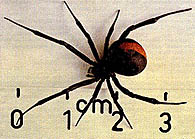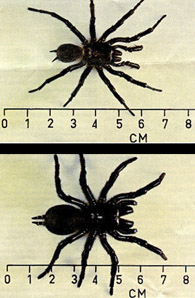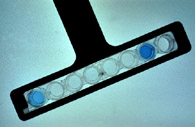
CSL antivenoms
1956
antivenoms for treating spider and snake bites
The Commonwealth Serum Laboratories (CSL) have been involved with antivenom research since the 1920s. They have developed important antivenoms including those for redback spider, funnel-web spiders and all deadly Australian snakes.
When a female redback spider injects you with venom it can kill you, or at least make you sick. Saul Weiner, working at CSL, took two years to develop an antivenom which now saves about 250 lives a year. It involved 'milking' the venom from thousands of spiders then injecting it into horses. Although horses don't become sick from the venom, they start to make antibodies which then circulate in their blood. The antibodies are purified from the horses' blood and used as antivenom. When injected into a human, they recognise and neutralise spider venom in the victim's body.
For many years funnel-web spiders and their vicious bites were sensationalised on TV, but the funnel-web really is deadly, and it happens to live on the heavily populated east coast of Australia. Developing a funnel-web antivenom was a focus for Australian scientists and doctors for many years.
A team led by Dr Struan Sutherland at CSL successfully identified the major toxin (poison) in the spider's venom in 1976. Funnel-web venom is toxic only to humans, chimpanzees and newborn mice, so they isolated and purified the toxin, then injected it into rabbits, which responded by making antibodies. These antibodies were purified from the rabbits' blood and were used as the main component of an antivenom. It was tested on mice and chimpanzees before being given to humans in 1981.
CSL released the first tiger snake antivenom in 1930. Taipan, brown snake, death adder and Papuan black snake antivenoms came out in the1950s.
In 1968 a polyvalent antivenom (that is, one that works for all Australian snakes) was developed. Although highly effective, a large dose was needed, and this could sometimes cause a bad reaction in the patient. The Snake Venom Detection Kit, released in 1990, overcomes this problem. It uses a sample of venom from the wound to identify which type of snake did the biting. A small amount of the specific antivenom from the kit can then be injected to save the patient's life.
Other antivenoms produced in Australia by CSL include those against sea snakes and the sea wasp.
Who Did It?
Key Organisations
Commonwealth Serum Laboratories Limited : R&D, manufacture
Key People
Saul Wiener : researcher ? redback antivenom
Struan Sutherland : team leader ? funnel web antivenom
John C Cox : research
Further Reading
'Management of spider bites in Australia'
S K Sutherland
Australian Prescriber, no 5, 1981, pp 83-87.
Management of snake bite injuries
S Sutherland & K King
Royal Flying Doctor Service Monograph Series, 1991.
Links
CSL Online
Queensland
Museum Spiders
CSL
Antivenom Handbook
Funnel
Web Spiders
Australian
Venom Research Unit
Australian Reptile Park
International Venom
and Toxin Database
Toxinology
Homepage
|












